
Product test
Segway ZT3 Pro D tested: robust e-scooter for comfortable excursions
by Lorenz Keller

I rode the 26 kilometres from Hegi Castle to Frauenfeld Castle and back on the Segway Max G3 D and can conclude that it’s reliable, safe and cheaper than many of its competitors. It’s only occasional drawback is that it’s not super comfortable.
With the launch of the Max G3 D, Segway-Ninebot wants to enter the royal league of scooters at a price mere mortals can afford. The e-scooter with double suspension, powerful brakes and a long range costs 829 francs, which is less than other high-end models.
I took the scooter on a test ride from Hegi Castle in Winterthur to Frauenfeld Castle in the heart of the eponymous capital of the canton of Thurgau. Neither of the 13th century castles were home to kings or princes. At most, they would’ve been home to «Landvögte» (bailiffs) or minor noblemen and -women, who would’ve felt a bit like aristocracy. Just like me on my inexpensive e-scooter.
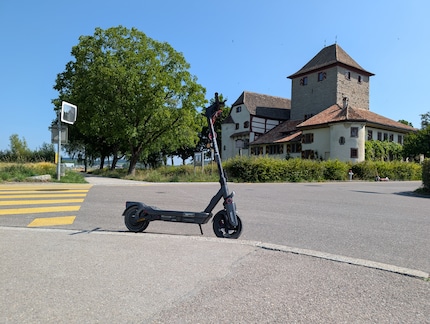
After taking a few snaps of Hegi Castle in the east of Winterthur, I set off. 13 kilometres there and 13 kilometres back lie ahead of me: 92 metres of elevation, 141 down – and back again.
The e-scooter has to prove what it’s made of after just a few kilometres. Why? Because the path through the local countryside and past the glider airfield isn’t asphalted. In any case, I’m glad the Segway has hydraulic suspension.
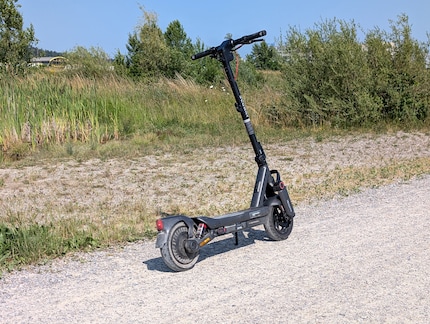
There’s hydraulic suspension at the front and back. This softens small bumps very well, which makes for a comfortable ride at a top speed of 20 km/h along the dirt road.
This is the perfect surface to carry out a brake test. Fortunately, the scooter has disc brakes at the front and rear that have great grip. However, there’s no electronic braking system like you see on more expensive models, so you have to be careful on loose ground. The wheels are stopped pretty quickly on this surface and I skid over the gravel.
The route continues through the rural community of Wiesendangen and along deserted country roads heading towards Thurgau. Zipping along this route is very pleasant. Standing on the generous footboard is comfortable and the tubeless 11-inch wheels roll along smoothly.
The powerful motor comes in handy on gentle inclines. The output power is 500 watts and the maximum power 2,000 watts. This means I can cover the entire route at 20 kilometres per hour and even overtake a few cyclists as I’m going uphill.
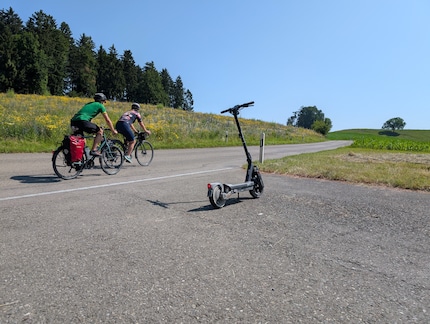
However, as the incline increases, I need to switch to sport mode. Although it doesn’t make the Segway-Ninebot Max G3 D go faster, you also have more power reserves at your disposal. However, this also drains the battery faster. For example, you can use it to get up an underground car park ramp with an 18-degree incline.
The route leads downhill towards Gachnang. Without accelerating, the e-scooter rolls at a pace of 24 or 25 km/h. But it doesn’t like this at all. A warning on the large, easy-to-read display lights up and the Segway even starts to beep. Other models don’t do this. Besides, it’s not necessary as long as you’re going under the speed limit, which was 50 km/h in my case.
The scooter makes far too many annoying noises for my taste in general. For example, when you indicate or switch it on. Fortunately, you can switch off the sounds in the app.
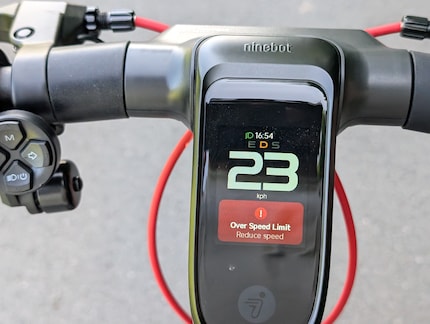
After purchase, you need to install the app, create an account and connect the scooter once to activate it and link it with the settings for your country. After that, you don’t need the app to ride. However, I did come across some useful settings in the app. There’s an immobiliser or you can connect to Apple’s «Find My» network so you can locate the scooter more easily.
In the village of Gachnang, I come across a surprisingly short stretch of cobblestones next to the 13th-century church. This is where the suspension system of the Max G3 D reaches its limits. The blows are very noticeable. The telescopic dampers in the Segway ZT3 Pro D, for example, counteract these kinds of bumps much better.
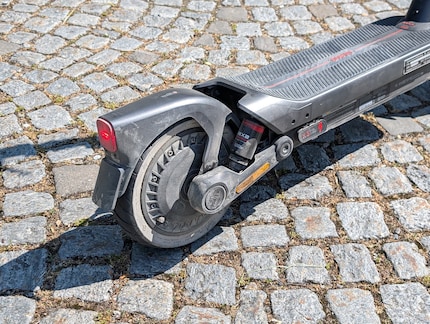
Check out the review of the more expensive and heavier Segway model:
I arrive in Frauenfeld after a 45-minute ride. I park the scooter right in front of the castle on the edge of the old town.
As the Historical Museum (page in German) located in the building is only open in the afternoon, I treat myself to lunch with a view of the castle. I can highly recommend the crispy fried fish served up in the restaurant Scharfe Eck.

My verdict so far? The Segway Max G3 D is a sturdy e-scooter with plenty of power, which makes it well suited for longer distances. The suspension is on the hard side, which is good enough for small bumps on gravel paths. However, in a city with lots of cobblestones I would opt for a different model.
Weighing in at 24.5 kilos, you can lift the two-wheeler and stow it in a car boot, for example. The weight is owed to its solid construction on the one hand and the large battery on the other. I’ll find out at the end of the trip whether Segway can keep its range promise of 75 to 80 kilometres. But first, it’s time to ride back.
I know the way now, so I can enjoy the ride. I whizz past chickens, cows, goats and ponies, but am missing a technical assistant. Namely, cruise control, which some competitors have. As there’s no way of entering a constant riding speed; I need to keep pressing the throttle.
Segway has also done without other bells and whistles on this model. The only luxury apart from the suspension are the indicators in the handlebars. Electronic aids such as traction control, anti-lock braking or even cruise control haven’t been included.
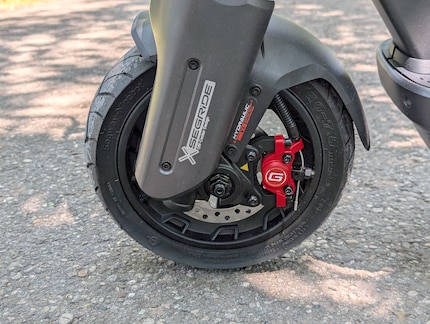
Shortly before the end of my castle-to-castle ride, I treat myself to a delicious almond croissant at Meier’s bakery in Wiesendangen. This should give me enough energy for the final stretch to Hegi Castle.

The scooter displays a battery level of 30 per cent. In other words, I used 70 per cent of the battery to cover 26 kilometres. I wouldn’t even have managed 40 kilometres on one charge in this test. However, Segway promises a range of 75 kilometres at a speed of 20 km/h, and even 80 kilometres at 15 km/h. As with all other manufacturers, this figure is measured on a flat road with a rider weighing 80 kilos.
So for me a range of around 50 kilometres with a full battery is more realistic. Incidentally, the deviation from the manufacturer’s specs isn’t an outlier. I’ve noticed this in all tests so far. The Navee ST3 Pro, for example, is advertised as having a range of 75 kilometres. But I only managed 30 kilometres in my test with less incline and not 40 kilometres like I did with the Segway.
When I get home, I kick back after the long journey and plug the scooter into the power supply. The good news is that a simple power cable is all you need. Segway has built the transformer directly into the scooter. So unlike competitor models, it doesn’t require a large black box that you have lying around on the floor. The Max G3 D charges from 0 to 100 per cent in just three and a half hours. This is excellent, as other models take twice as long. With an optional DC charger, I could even reduce the time to two and a half hours. The e-scooter has a second charging input for this purpose.
The Segway-Ninebot Max G3 D is a stable and robust e-scooter with a powerful motor and good disc brakes. Its range is good, but far less impressive than what the manufacturer states in the specs.
For a fair price, you get a comprehensive overall package that makes do with very few extras. There are no electronic helpers, for example. The suspension is good on normal roads or dirt tracks, but the scooter’s unable to take the edge off larger bumps.
Overall, the Segway-Ninebot Max G3 D is good, but also unspectacular. Compared to the competition, the overall package is solid, but it only stands out because of its fast charging system and attractive price.
Pro
Contra
Gadgets are my passion - whether you need them for the home office, for the household, for sport and pleasure or for the smart home. Or, of course, for the big hobby next to the family, namely fishing.